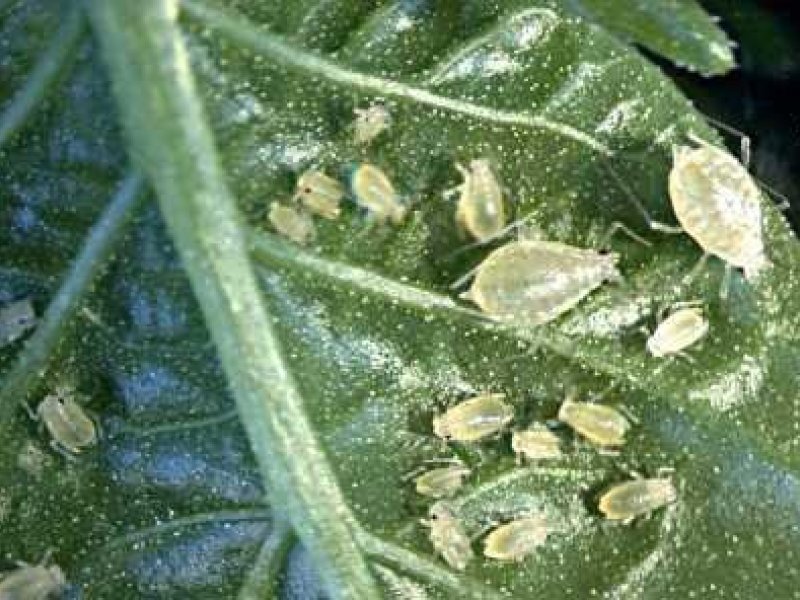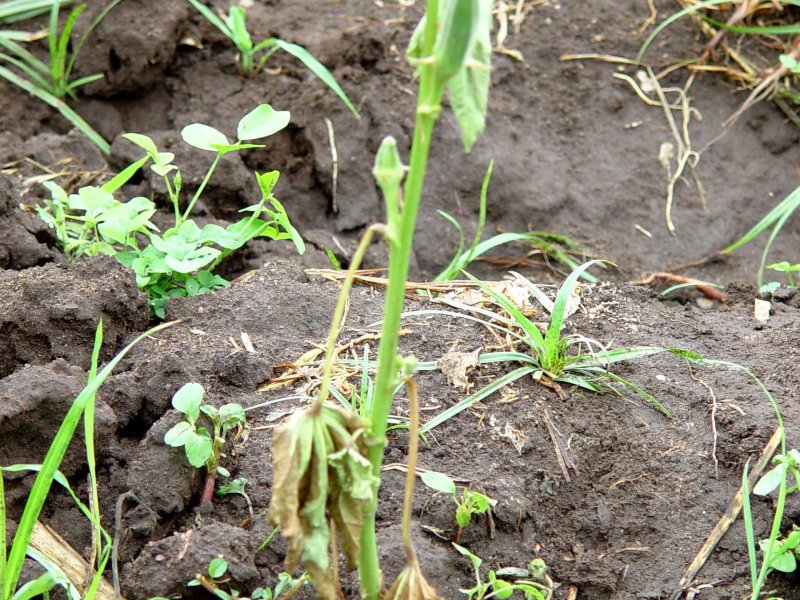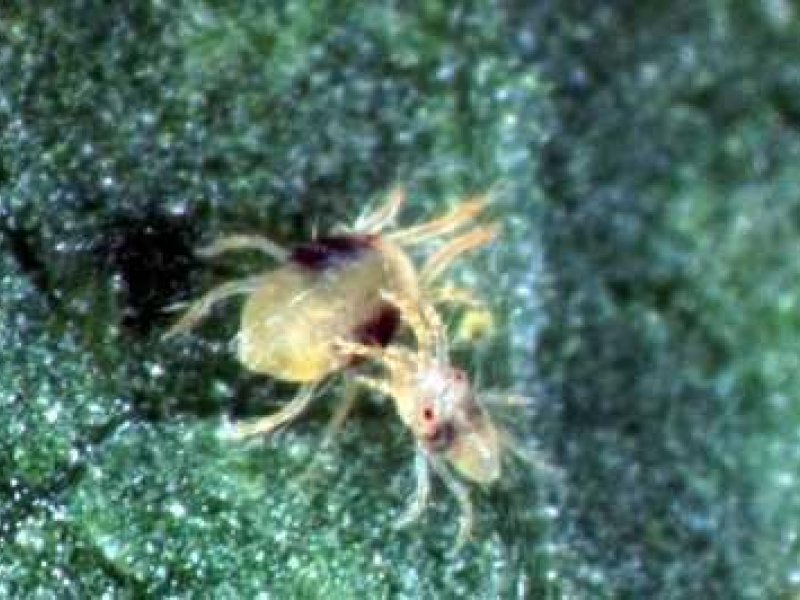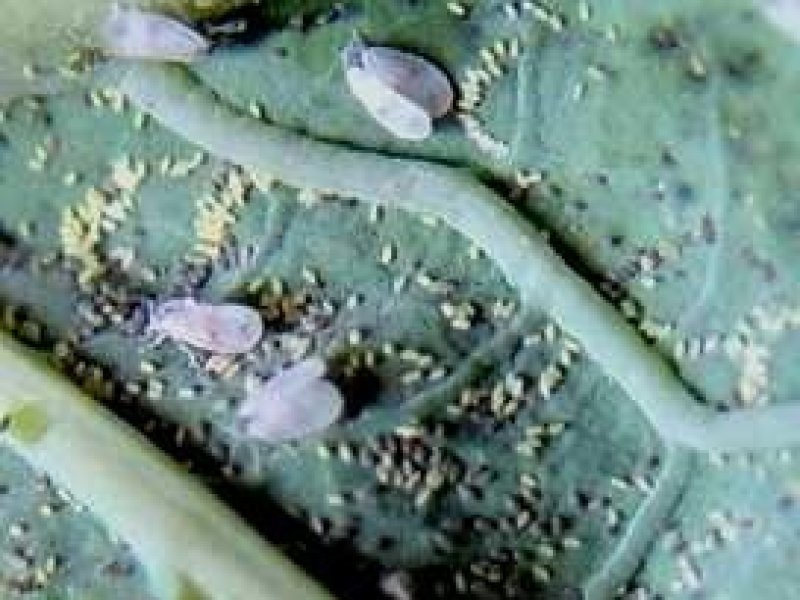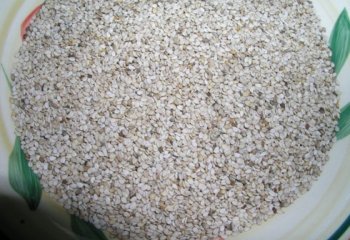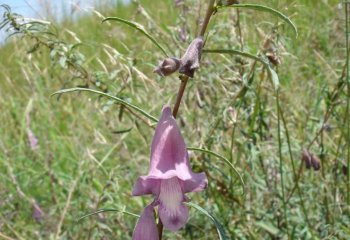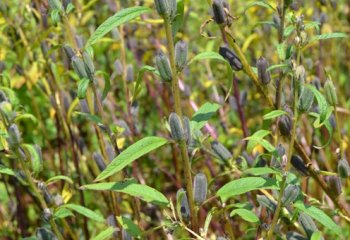|
Aphids (Aphis spp.) Aphids are a major pest, causing leaves to curl and attacked capsules become unattractive to customers. Aphids feed by sucking plant sap. Small aphid populations may be relatively harmless, but heavily infested plants usually have wrinkled leaves, stunted growth and deformed capsules. Plants, in particular young plants, may dry out and die under heavy aphid attack. Heavy attack on older plants may cause crop loss by decreasing flower and seed production. Damage may also reduce seed viability. |
|
|
What to do:
|
|
Bacterial blight (Xanthomonas campestris pv. sesami) Water soaked, small and irregular spots are formed on the leaves which later increase in number and turn brown. Severely infected leaves defoliate. Later, the spots are formed on the twigs which bear poor capsules. Spots appear from 4 to 6 leaf stage of the crop and continue till maturity. Seed treatment with hot water at 52°C for 10 minutes is recommended.
|
|
|
What to do:
|
|
Bacterial leaf spot (Pseudomonas syringae pv. sesami) Light brown angular spots with dark purple margin appear in the leaf veins. Defoliation and death of plant may occur in severe leave and stem infection. Sunken and shiny spots appear on the capsules. Early capsule infection renders them black and seedless. The pathogen is seed borne. High temperature, rainfall and persistent humidity favour the disease.
|
|
|
What to do:
|
|
Cutworms (Agrotis spp.) Cutworms are caterpillars of Agrotis moth. The adult moth is grey to brown with a wingspan of about 4 cm and have lighter coloured hind wings. Whitish yellow eggs are laid at night on leaves. The eggs turn darker as hatching approaches. Young larvae may feed on leaves and cause tiny holes but they drop to the ground after a few days.
Mature larvae are about 4 cm long. They are easy to recognise by their smooth skin, greasy grey / orblack colour and C-shaped posture when disturbed. Cutworms emerge at night causing serious damage by cutting young plants at the base of the stem. Cutworm infestation is often associated with fields that are weedy, have high amounts of organic residue or are very wet due to poor drainage or heavily irrigated.
|
|
|
What to do:
|
|
Fusarium wilt (Fusarium oxysporum f. sp. sesam) It is a fungal disease. Symptoms include partial or total wilting of plants at flowering and podding, a purple band of stems extending from the base upwards, browning of the stem tissue in the purple band area, and browning or blackening of internal tissue when the main stem or primary branches are split. Infected young plants may not show the purple band symptom but have conspicuous internal browning and blackening. Affected fields show patches of dead plants. The fungus survives on infected crop debris in the soil for about three years. Infection occurs from seeds or soil. Non-opening varieties are not as susceptible.
|
|
|
What to do:
|
|
Leaf spot (Alternaria spp.) The pathogen attacks all parts of the plant at all stages. Small, dark brown water soaked, round to irregular lesions, with concentric rings, 1-8 mm in diameter appear on the leaves and under excessive atmospheric and soil humidity the spot increases in size and number. The lesions may also appear on the midrib and veins of the leaves. Milder attacks cause only defoliation, in severe cases the plant may die. The pathogen is seed-borne. Temperature of 20-300C and humid conditions favour the disease.
|
|
|
What to do:
|
|
Powdery mildew (Sphaerotheca fuliginea, Leveillula taurica, Erysiphe cichoracearum) The disease can infect all aerial parts: leaves, flowers and pods. Characteristic of the disease is white greyish powdery fungal growth on affected plant parts. Small pale yellow chlorotic spots develop on the upper surface of leaves and the corresponding lower surface develops white greyish powdery fungal growth. With time the powdery growth covers the entire upper and lower leaf area. Severe infection causes heavy leaf drop. The fungus develops at temperatures ranging from 20 to 35°C, but 25°C is the optimum. The fungus survives on perennial pigeon peas and volunteer plants, and on the ratoon growth of the harvested plants. |
|
|
What to do:
|
|
Simsim gall midge or gall fly (Asphondylia sesami) The adult is a 5 mm long red-bodied midge (mosquito-like fly). Female midges lay eggs along the veins of terminal leaves. The larvae are typical maggots; they are whitish to orange in colour, legless and with body tapering exteriorly and grow up to 3 to 4 mm in length. Maggots feed inside the floral buds and young capsules leading to formation of galls of up to 6 mm in diameter. They pupate inside the galls. Attacked flower buds wither and drop, or become twisted and stunted and do not develop in to flower/capsules. The simsim gall midge is usually a minor pest, but occasionally high infestations occur resulting in considerable crop losses. Generally plants with green capsules appear to be more susceptible to attack than plants with black capsules. |
|
|
What to do:
|
|
Spider mites (Tetranychus spp.) Eggs of red spider mites are round, white or pink and of size about 0.1 mm. Eggs are usually laid on the under-surface of leaves. They hatch into six-legged larvae, light green in colour, which become reddish coloured adults. The adults are about 0.25 -0.6 mm long. They have eight legs, and produce a fine silk webbing that protects them predators and pesticide sprays. Infested leaves are spotted, yellowish or silvery as a result of feeding by red spider mites. Infested capsules exhibit white speckling. The red spider mites are dispersed by wind and human activity on clothes while working in infested fields. Their development is favoured by warm weather and insufficient rains.
|
|
|
What to do:
|
|
Stem rot (charcoal rot of bean) (Macrophomina phaseolina) Initial symptom on stems and branches are spindle-shaped spots with light grey centres surrounded by brown margins. The centres of the spots have scattered dots (pycnidial bodies - fungal spores). The spots may join up and cause the branches or whole plants to dry up and die. The fungus mainly attacks secondary finer roots. These roots have dark, blackened streaks underneath their barks with dots (pycnidial bodies - fungal spores). Diseased plants suddenly wilt. When diseased plants are uprooted their roots are rotten and shredded. Disease development is favoured by hot dry weather (30 degC). Crops are more susceptible to the disease in the reproductive than in the vegetative stage. |
|
|
What to do:
|
|
Whiteflies (Bemisia tabaci) Whiteflies are extremely polyphagous. They are a vector of many virus diseases. Whitefly feeding produces a honeydew, which is conducive to the development of sooty mould and also attracts ants. Whitefly incidence is favoured by dry conditions .
|
|
|
What to do:
|
Geographical Distribution in Africa
Geographical Distribution of Sesame in Africa. Updated July 2019. Source FAOSTAT
© OpenStreetMap contributors, © OpenMapTiles, GBIF. https://www.gbif.org/species/3172622.
Read more
Angola: (olo) sakwa
Benin: Agboman (Fon) (Koné et al., 2019).
Burkina faso: Éfiandron (Baoulé), Lanca Mouni (Ninengué) (Koné et al., 2019).
DRC: Bonanguila (Beembé, Doondo) ; Wangila (Kikongo) (Koné et al., 2019).
Ghana: Sesame (Twi dialect) (Koné et al., 2019).
Ivory coast: Anana (Ebrie) (Koné et al., 2019).
Madagascar: Voahazo (Koné et al., 2019)
Morocco: Jenjlân (Koné et al., 2019).
Mauritius: Gingeli Ou Sésame (Creole); Yellou Eunnay (Tamoul) (Koné et al., 2019).
Mali: Poli "Tonmo Soo"É (Bandiagara)
Togo: Agbon (Adja), Adeflo (Ewé) (Koné et al., 2019). ).
Uganda: Landi (Alur)
General Information and Agronomic Aspects
Introduction
Sesame (Sesamum indicum) is a tropical and subtropical plant in the family Pedaliaceae and the genus Sesamum, valued for its edible seeds, oil, and flavor. The genus Sesamum consists of approximately 20 species, with the majority being native to the tropical regions of Africa.
S. indicum is believed to have originated in East Africa, particularly in the region that spans from Ethiopia to Sudan and is the oldest of the commercial oil seeds. Sesame seed is one of the oldest oilseed crops known, domesticated well over 3,000 years ago. The oil is a clear edible oil with a pleasant taste and a very good long shelf life if properly refined. Sesame has an oil content of 48-55% which is the highest of any oil crop while the protein content ranges from 44 to 48%.
Ⓒ Adeka et al., 2005
It is now cultivated throughout the tropical and subtropical areas in Asia, Africa, and South America. Major sesame-producing countries include India, China, Myanmar, Sudan, Ethiopia, and Nigeria. Sesame is an excellent rotation crop of cotton, maize, groundnut, wheat, and sorghum. It reduces nematode populations that attack cotton and groundnut. It is also an excellent soil builder - as it improves the soil texture and moisture retention and lessens soil erosion. The composted sesame leaves left on the soil binds the ground; retains soil moisture better for planting the next crop; and increases the yield of the following crop. Sesame is resistant to drought, tolerant to insect pests and diseases, a low-cost crop and therefore one of the best alternative specialty crops.
Sesame seeds are either consumed directly as a highly nutritious foodstuff or processed by the confectionery and bakery industries. The seed hulls, which are bitter due to their oxalic content, can be removed with the use of steam. Ragouts and soups are often prepared with crushed sesame seeds. Sesame hay, if carefully dried, can be used as fodder. A large proportion of the world's sesame production goes towards producing edible oil. Purely white sesame seeds are in demand on conventional and on ecological markets, because of their higher oil content than pigmented varieties. By-products of oil extraction are an excellent protein component to mix into animal feed.
The seed hulls, which are bitter due to their oxalic content, can be removed with the use of steam. Ragouts and soups are often prepared with crushed sesame seeds. Sesame hay, if carefully dried, can be used as fodder. A large proportion of the world's sesame production goes towards producing edible oil. Purely white sesame seeds are in demand on conventional and on ecological markets, because of their higher oil content than pigmented varieties. By-products of oil extraction are an excellent protein component to mix into animal feed. (Mkamilo & Bedigian., 2007).
Species account
Sesamum indicum is an annual, or occasionally perennial herbaceous plant. Stems: erect, branching, reach heights of 1-2 m depending on the variety and growing conditions. It is typically covered in fine hairs. Leaves: simple, alternate, and lanceolate to ovate in shape.. Flowers: solitary, tubular flowers with five petals, vary in color from white to pink. Fruit: a capsule that is typically oblong or rectangular in shape, measuring about 2 to 4 cm in length. When mature, capsule splits open along its seams to release small, oval-shaped seeds. Seeds: small and flat, measuring about 2 to 4 mm in length, vary in color, with common varieties being white, black, brown, or yellow. The seeds are rich in oil and are covered by a thin seed coat.
(Heuzé et al., 2021.
Related species
Sesamum alatum commonly known as the Winged sesame is found across tropical Africa thriving in arid areas from Senegal to South Africa. It has also been introduced in Madagascar, India, and on occasion, in other regions.
The plant is an erect annual herb, 50-150 cm. Leaves: heteromorphic: lower leaves 3-5-foliolate or very deeply divided with narrow, linear-lanceolate lobes; upper leaves simple, glabrous, except for some mucilage glands; margin entire. Lower leaves 3-5 segmented and prickly outgrowth present on the leaf Petiole Flowers: 3.5 cm in diameter, pink or light purple outside and red to dark purple in side with reddish-purple spotted within. Fruit: narrow, oblong, long beaked capsule. Seeds: winged at both end, black, rough, 2.5-3mm long.
The leaves and young shoots are gathered from the wild and cooked as a vegetable, often seasoned with crushed seeds. The seeds are sometimes prepared separately as a relish or boiled with pumpkin leaves, served with a staple food. Seeds yield edible oil and are employed as an aphrodisiac and for treating diarrhea and intestinal problems (Jansen, 2004, Hyde et al., 2023).
Sesamum angustifolium (Oliv.) Engl. (Mfuta mwitu (Swahili))
This is a usually erect herb, rarely straggling, sparingly branched, to 1.3 m, occasionally higher. Stems angled, finely hairy. Leaves: Narrow, long. Flowers: Funnel-shaped, pink to reddish purple, hairy, longer lip pale inside with purple lines.
Found from Nigeria east to Sudan and Ethiopia and south to Namibia and Mozambique. It occurs in abandoned cultivated land, grassland, roadsides, 0-3,000 m. Common in light clay and sandy soils.
It is used as a vegetable by the Luhya, Luo, Teso and Mijikenda of Kenya. The vegetable is has a mucilaginous texture and a slight odour. It is normally cooked with Corchorus, beans and peas and used to thicken sauces. The oil is used to treat ringworm in Uganda (Busoga), while ground leaves combat baldness (Boni). Leaves mixed with water help with eye troubles and infant diarrhea. The mucilage is used for burns and wounds, and crushed leaves add shine to hair during washing. It's also used to relieve stomachaches among the Kamba in Kenya (Maundu et al., 1999.
Sesamum calycinum Welw.
The native range of the species is Congo to South Tropical Africa. In Kenya it occurs in abandoned cultivated lands, grassland, roadsides, 0-3000m. common in light clay and sandy soils.
The plant is an erect annual or perennial herb, rarely straggling, sparingly branched, grows to a height of 1.3 m, occasionally higher. Stems: angled, finely hairy. Leaves: Narrow, long. Flowers: Funnel-shaped, flower. The leaves and shoots are occasionally collected from the wild and consumed as vegetables.
Varieties
There are local varieties of sesame with black, white and brown seed colors. The black varieties are grown in the coastal region and the white in the western region of Kenya.
Imported varieties have lower performance than local varieties. The best of the imported varieties is "Morada", identified by its purple stems and leaves. It originated in Congo and further selected in Venezuela. It is higher yielding and more resistant to aphid attack. The local sesame varieties are branched and drought resistant but have a low yielding capacity and are susceptible to most diseases. KS-S6 variety can be grown from 200-1000 masl, gives an average yield of 2.5-3.0 tons/ha. This variety has a high poding ability, is tolerant to rust and shootfly.
Ecological information
Sesame needs a constant high temperature, the optimum range of growth, blossoms and fruit ripeness is 26 to 30degC. Sesame only grows well in a warm climate and in East Africa it is only grown from sea level up to 1500 m. Most varieties of sesame are photoperiod sensitive.
In Kenya sesame is grown in the following areas:
• Coast Province - Kwale, Kilifi and Lamu districts
• Western Province - Busia, Bungoma and Kakamega
• North Eastern Province - Mandera
• Eastern Province - Meru
Good harvests can be expected when rainfall of 300-600 mm is equally distributed throughout the vegetation period. Optimum rainfall times: 35% before the first cusps are formed, 45% during the main blossoming period, 20% during the ripening period. Drought during harvesting is preferred. During each of its development stages, the plant is highly susceptible to water-logging, and can therefore only thrive during moderate rainfall, or when irrigation is carefully controlled in drier regions. Due to its tap roots, the plant is highly resistant to drought and can provide good harvests, when soil moisture is adequate.
A wide range of soils are suitable for sesame cultivation. Optimal are well-drained, loose, fertile and sandy alluvial soils that have a pH value between 5.4 and 6.75. When irrigated, or during summer rain spells, sesame grows better in sandy than in heavy soils because it is very sensitive to high soil moisture content. It is not recommended to plant sesame on sloping ground, because its need of weed-free seed beds and its slow rate of early development can lead to erosion. Sesame tolerates temperatures of 24-33degC and the crop matures in 120-140 days.
Agronomic aspects
Sesame is often sown as an opening crop in a rotation, as it requires a fertile soil. In this case grasses must be eradicated as sesame is a poor competitor to weeds. Planting must be done as early in the rains as possible. A rough seed bed is required despite the small seed size of sesame. A smooth seedbed with a fine tilth is more likely to form a hard cap after heavy rains and prevent germination.
There are several cultivation methods:
• Direct sowing in holes, with stick for support.
• Sowing after narrow strips have been prepared.
• Drilling in rows about 45 cm apart and later thinned (at a height of about 5-10 cm) to a distance of 15-20 cm within the row.
The optimum depth to sow is around 1.5 to 2.5 cm. It is important to sow at an even depth to ensure simultaneous and uniform growth of the crop. Small-holder farmers will often sow by hand.. This method requires 5-10 kg/ha of seeds. Mixing seed with sand, dry soil, ash or dried, sieved manure or compost will help to make seed distribution more uniform. In order to achieve an optimum crop density, branching varieties should be singled out to 6-10 cm, or definitely less than 15 cm distance within the rows when they reach a height of 5-10 cm.
Intercropping
Sesame is often sown with other crops such as pigeon peas, maize or sorghum. It grows to a height of 1-2 m.
Husbandry
Young sesame plants grow very slowly during the first 25 days, due to the small seed size, and are not yet strong enough to compete against weeds. Natural weed resistance sets in when growth rapidly accelerates, after the plants have attained a height of 10 cm. For this reason, the field should be kept as weed-free as possible during the first 20-25 days after seeding. This is usually achieved through 2-3 hand cultivations or by slashing weeds at soil surface as soon as practically possible, and hand weeding the rows of crops.
Additional measures in weed control include:
• Early working in of the weeds and harvest residues from the previous crop.
• The planting of rapidly-growing varieties.
• Include plants in the crop rotation that cast strong shadows, or are good ground coverers (e.g. green manure plants).
• Bottom crops: Ground-covering legumes can be sown between the rows to suppress weed growth (e.g. groundnuts).
Harvest, post-harvest practices and markets
Harvesting
Sesame matures between 3-4 months. It ripens very unevenly with the bottom seeds ripening first. Capsules shattering to shed their seeds is a problem in harvesting. If harvesting is delayed, most of the yield will be lost.
The plants are cut to a height of 10-15 cm, or uprooted before the capsules are fully ripened. The optimum time for harvesting is when:
- The first, lowest capsules turn brown and begin to pop open.
- The stem turns yellow.
- The leaves begin to fall off.
- Blossoming has finished.
- The leaves have turned yellow.
Sesame is generally harvested by hand, and then left to dry for the first 2-3 days after cutting in a windrow. The leaves dry out quickly there, making it easier to bundle them into sheaves. The sheaves should be positioned so that the sun can shine down directly onto the capsules. The sheaves should be small (diameter of 15 cm, bottom: 45-80 cm). During harvesting, the planting seeds should not be allowed to come into contact with the ground to avoid an infestation of soil borne diseases. The seed shells must remain intact to protect the seeds from infection, and to maintain their ability to germinate.
When the sheaves have dried out fully, they are tipped out onto sturdy cloths or canvases and threshed with sticks. To achieve maximum quality (and market price) the threshing cloths/canvases should be at least 2mx3m to avoid contamination with soil particles. Directly following the threshing, the sesame seeds are sieved of leaves, stems and capsule residues, and then dried out to a moisture content of 6% as rapidly as possible. This can be done on a clean, sun-drenched concrete base preferably covered by a clean plastic sheet to avoid contamination.
Yields
With good management, yield should be between 450-550 kg/ha. "Morada" variety can yield twice.
(Naturland e.V. 2002)
Post-harvest practices
When the sheaves have dried out fully, they are tipped out onto sturdy cloths or canvases and threshed with sticks. To achieve maximum quality (and market price) the threshing cloths/canvases should be at least 2mx3m to avoid contamination with soil particles. Directly following the threshing, the sesame seeds are sieved of leaves, stems and capsule residues, and then dried out to a moisture content of 6% as rapidly as possible. This can be done on a clean, sun-drenched concrete base preferably covered by a clean plastic sheet to avoid contamination. Prolonged exposure of the pods to the sun could affect both seed quality and seed germination.
Sesame seeds are best stored unshelled, in dry conditions protected from rain and pests. The seeds for storage should have 10% moisture content.
Markets
Sesame is marketed in a variety of forms, each with its unique applications and appeal. The whole sesame seeds available in different varieties such as raw, hulled or unhulled, or roasted. These seeds are versatile, used for both culinary and garnishing purposes in various dishes. Sesame oil, obtained from these seeds, is another marketable product. It's ideal for cooking due to its high smoke point and has a distinctive nutty flavor. It's also used in salad dressings and flavoring in numerous cuisines.
Tahini, a paste made from ground sesame seeds, is popular in Middle Eastern and Mediterranean dishes. It can be used in dips, sauces, or as a spread. Sesame is a key ingredient in snack products like sesame bars, crackers, and sticks, often marketed as healthy alternatives. Sesame flour is also marketed as a gluten free alternative for baking. Sesame-based spreads, similar to nut butters, are another product in demand, often flavored with honey or chocolate.
Sesame frequently features in snack mixes like trail mixes and granola bars, adding crunch and nutrition. Additionally, sesame oil finds its way into beauty and personal care products, from skincare to hair care, thanks to its nourishing properties (Robbins, 2023).
Table 1: Proximate nutritional value per 100g edible portion
Code Food Name |
Seed, sesame (sim sim) unsalted, dry, raw |
Recommended daily allowance (approx.) for adults a |
Edible conversion factor |
1 |
|
Energy (kJ) |
2490 |
9623 |
Energy (kcal) |
602 |
2300 |
Water (g) |
4.9 |
2000-3000c |
Protein (g) |
15.3 |
50 |
Fat (g) |
54.1 |
<30 (male), <20 (female)b |
Carbohydrate available (g) |
6.4 |
225 -325g |
Fibre (g) |
14.3 |
30d |
Ash (g) |
5 |
|
Minerals |
||
Ca (mg) |
1430 |
800 |
Fe (mg) |
9.7 |
14 |
Mg (mg) |
333 |
300 |
P (mg) |
803 |
800 |
K (mg) |
322 |
4,700f |
Na (mg) |
7 |
<2300e |
Zn (mg) |
1.72 |
15 |
Se(mg) |
21 |
|
Bioctive compounds. |
||
Vit A RAE (mcg) |
0 |
800 |
Vit A RE (mcg) |
1 |
800 |
Retinol (mcg) |
0 |
1000 |
b-carotene |
5 |
600 – 1500g |
Thiamin (mg) |
1.01 |
1.4 |
Riboflavin (mg) |
0.34 |
1.6 |
Niacin (mg) |
5.1 |
18 |
Dietary Folate Eq. (mcg) |
103 |
400f |
Food folate (mcg) |
103 |
400f |
Vit B12 (mg) |
0 |
3 |
Vit C (mg) |
0 |
60 |
Source (Nutrient data): FAO/Government of Kenya. 2018. Kenya Food Composition Tables. Nairobi, 254 pp. http://www.fao.org/3/I9120EN/i9120en.pdf
a Lewis, J. 2019. Codex nutrient reference values. Rome. FAO and WHO
b NHS (refers to saturated fat)
c https://www.hsph.harvard.edu/nutritionsource/water/
d British Heart Foundation
e FDA
f NIH
g Mayo Clinic
h-West African food composition table
Nutritive Value per 100 g of edible Portion
| Raw or Cooked Sesame | Food Energy (Calories / %Daily Value*) |
Carbohydrates (g / %DV) |
Fat (g / %DV) |
Protein (g / %DV) |
Calcium (g / %DV) |
Phosphorus (mg / %DV) |
Iron (mg / %DV) |
Potassium (mg / %DV) |
Vitamin A (I.U) |
Vitamin C (I.U) |
Vitamin B 6 (I.U) |
Vitamin B 12 (I.U) |
Thiamine (mg / %DV) |
Riboflavin (mg / %DV) |
Ash (g / %DV) |
| Sesame Oil | 884.0 / 44% | 0.0 / 0% | 100.0 / 154% | 0.0 / 0% | 0.0 / 0% | 0.0 / 0% | 0.0 / 0% | 0.0 / 0% | 0.0 IU/ 0% / | 0.0 / 0% | 0.0 / 0% | 0.0 / 0% | 0.0 / 0% | 0.0 / 0% | 0.0 |
| Sesame seeds, whole, dried | 573.0 / 29% | 23.4 / 8% | 49.7 / 76% | 17.7 / 35% | 975.0 / 98% | 629.0 / 63% | 14.5 / 81% | 468.0 / 13% | 9.0 IU / 0.0 | 0.0 / 0% | 0.8 / 40% | 0.0 / 0% | 0.8 / 53% | 0.2 / 15% | 4.5 |
*Percent Daily Values (DV) are based on a 2000 calorie diet. Your daily values may be higher or lower, depending on your calorie needs.
Recipes
Community: Luhya
Inderema
Butere-Mumias, Kenya
Inderema (Vine spinach, Basella alba)
Water
Soda or Traditional lye
Simsim (Sesame)
Procedure
1. Plucked leaves are placed in a pot. Among the Kisa of west Kenya it is called ‘eyamunyu’.
2. Water is then added followed by a solution of calcium carbonate and boiled to tenderness.
3. Boil then add ‘tsinuni (simsim)
Alternative cooking:
1. Plucked leaves are sun dried for half a day.
2. Then, they are boiled in a mixture of water and sodium carbonate solution
3. Ground groundnuts are then added i.e. that is, they are ground in a pestle with a mortar until they are soft.
Served with:
Serve cold with hot ugali.
Source: Maundu et al., 2004
| Aphids are a major pest, causing leaves to curl and attacked capsules become unattractive to customers. Aphids feed by sucking plant sap. Small aphid populations may be relatively harmless, but heavily infested plants usually have wrinkled leaves, stunted growth and deformed capsules. Plants, in particular young plants, may dry out and die under heavy aphid attack. Heavy attack on older plants may cause crop loss by decreasing flower and seed production. Damage may also reduce seed viability. What to do:
|
| Cutworms are caterpillars of Agrotis moth. The adult moth is grey to brown with a wingspan of about 4 cm and have lighter coloured hind wings. Whitish yellow eggs are laid at night on leaves. The eggs turn darker as hatching approaches. Young larvae may feed on leaves and cause tiny holes but they drop to the ground after a few days.
Mature larvae are about 4 cm long. They are easy to recognise by their smooth skin, greasy grey / orblack colour and C-shaped posture when disturbed. Cutworms emerge at night causing serious damage by cutting young plants at the base of the stem. Cutworm infestation is often associated with fields that are weedy, have high amounts of organic residue or are very wet due to poor drainage or heavily irrigated.
What to do:
|
| Simsim gall midge or gall fly (Asphondylia sesami) The adult is a 5 mm long red-bodied midge (mosquito-like fly). Female midges lay eggs along the veins of terminal leaves. The larvae are typical maggots; they are whitish to orange in colour, legless and with body tapering exteriorly and grow up to 3 to 4 mm in length. Maggots feed inside the floral buds and young capsules leading to formation of galls of up to 6 mm in diameter. They pupate inside the galls. Attacked flower buds wither and drop, or become twisted and stunted and do not develop in to flower/capsules. The simsim gall midge is usually a minor pest, but occasionally high infestations occur resulting in considerable crop losses. Generally plants with green capsules appear to be more susceptible to attack than plants with black capsules. What to do:
|
| Whiteflies are extremely polyphagous. They are a vector of many virus diseases. Whitefly feeding produces a honeydew, which is conducive to the development of sooty mould and also attracts ants. Whitefly incidence is favoured by dry conditions .
What to do:
|
| Spider mites (Tetranychus spp.) Eggs of red spider mites are round, white or pink and of size about 0.1 mm. Eggs are usually laid on the under-surface of leaves. They hatch into six-legged larvae, light green in colour, which become reddish coloured adults. The adults are about 0.25 -0.6 mm long. They have eight legs, and produce a fine silk webbing that protects them predators and pesticide sprays. Infested leaves are spotted, yellowish or silvery as a result of feeding by red spider mites. Infested capsules exhibit white speckling. The red spider mites are dispersed by wind and human activity on clothes while working in infested fields. Their development is favoured by warm weather and insufficient rains.
What to do:
|
| Stem rot (charcoal rot of bean) (Macrophomina phaseolina) Initial symptom on stems and branches are spindle-shaped spots with light grey centres surrounded by brown margins. The centres of the spots have scattered dots (pycnidial bodies - fungal spores). The spots may join up and cause the branches or whole plants to dry up and die. The fungus mainly attacks secondary finer roots. These roots have dark, blackened streaks underneath their barks with dots (pycnidial bodies - fungal spores). Diseased plants suddenly wilt. When diseased plants are uprooted their roots are rotten and shredded. Disease development is favoured by hot dry weather (30 degC). Crops are more susceptible to the disease in the reproductive than in the vegetative stage. What to do:
|
| Fusarium wilt (Fusarium oxysporum f. sp. sesam) It is a fungal disease. Symptoms include partial or total wilting of plants at flowering and podding, a purple band of stems extending from the base upwards, browning of the stem tissue in the purple band area, and browning or blackening of internal tissue when the main stem or primary branches are split. Infected young plants may not show the purple band symptom but have conspicuous internal browning and blackening. Affected fields show patches of dead plants. The fungus survives on infected crop debris in the soil for about three years. Infection occurs from seeds or soil. Non-opening varieties are not as susceptible.
What to do:
|
| The pathogen attacks all parts of the plant at all stages. Small, dark brown water soaked, round to irregular lesions, with concentric rings, 1-8 mm in diameter appear on the leaves and under excessive atmospheric and soil humidity the spot increases in size and number. The lesions may also appear on the midrib and veins of the leaves. Milder attacks cause only defoliation, in severe cases the plant may die. The pathogen is seed-borne. Temperature of 20-300C and humid conditions favour the disease.
What to do:
|
| Powdery mildew (Sphaerotheca fuliginea, Leveillula taurica, Erysiphe cichoracearum) The disease can infect all aerial parts: leaves, flowers and pods. Characteristic of the disease is white greyish powdery fungal growth on affected plant parts. Small pale yellow chlorotic spots develop on the upper surface of leaves and the corresponding lower surface develops white greyish powdery fungal growth. With time the powdery growth covers the entire upper and lower leaf area. Severe infection causes heavy leaf drop. The fungus develops at temperatures ranging from 20 to 35°C, but 25°C is the optimum. The fungus survives on perennial pigeon peas and volunteer plants, and on the ratoon growth of the harvested plants. What to do:
|
| Bacterial leaf spot (Pseudomonas syringae pv. sesami) Light brown angular spots with dark purple margin appear in the leaf veins. Defoliation and death of plant may occur in severe leave and stem infection. Sunken and shiny spots appear on the capsules. Early capsule infection renders them black and seedless. The pathogen is seed borne. High temperature, rainfall and persistent humidity favour the disease.
What to do:
|
| Bacterial blight (Xanthomonas campestris pv. sesami) Water soaked, small and irregular spots are formed on the leaves which later increase in number and turn brown. Severely infected leaves defoliate. Later, the spots are formed on the twigs which bear poor capsules. Spots appear from 4 to 6 leaf stage of the crop and continue till maturity. Seed treatment with hot water at 52°C for 10 minutes is recommended.
What to do:
|
References and information links
References
1. Acland, J. D. (1980). East African Crops. An introduction to the production of field and plantation crops in Kenya, Tanzania and Uganda. FAO / Longman Group Ltd, London. ISBN: 0 582 60301 3
2. Ahuja D. B., Kalian R. K. (2001). Seasonal incidence of gall fly, Asphondylia sesami and efficacy of various neem based formulations, against it on sesame, Sesamum indicum. Indian journal of entomology. Vol. 63, no4, pp. 409-412. ISSN 0367-8288.
3. Hill, D. S. (1975). Agricultural Insect pests of the tropics and their control. ISBN: 0-521-20261-2.
4. Insect Pest Management in Sesamum. In With Support of TIFP, Ministry of Science & Technology, Dpt. of Scientific & Industrial Research, GoI. Designed And Developed at Directorate of Instrumentation, JNKVV, Jabalpur, MP. www.jnkvv.nic.in
5. Sesame organic cultivation guide, 2002, Naturland. Available also online www.naturland.de
6. Nutrition Data www.nutritiondata.com.
7. Organisation for Non-Chemical Pest Management in the Tropics (OISAT). www.oisat.org
8. Koné, W. M., Atindehou, K. K., Dossahoua, T., & Betschart, B. (2019). Prelude medicinal plants database.
9. Heuzé V., Tran G., Bastianelli D., Lebas F., 2021. Sesame (Sesamum indicum) seeds and oil meal. Feedipedia, a programme by INRAE, CIRAD, AFZ and FAO. https://www.feedipedia.org/node/26 Last updated on August 27, 2021, 16:25
10. Hyde, M.A., Wursten, B.T., Ballings, P. & Coates Palgrave, M. (2023). Flora of Zimbabwe: Species information: Sesamum alatum.https://www.zimbabweflora.co.zw/speciesdata/species.php?species_id=152520, retrieved 17 October 2023
11. Robertson, R., PhD. (2023, February 21). 6 Super healthy seeds you should eat. Healthline. https://www.healthline.com/nutrition/6-healthiest-seeds
12. Robbins, O. (2023). What is sesame? Explore the benefits & uses of sesame seeds and tahini. Food Revolution Network. https://foodrevolution.org/blog/tahini-sesame-seeds-benefits
Review Process
Dr. Patrick Maundu, James Kioko, Charei Munene and Monique Hunziker, September 2024

